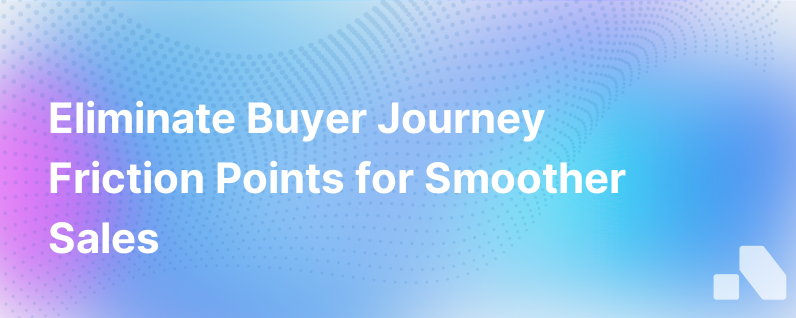
In the digitally-empowered landscape of modern sales, the buyer's journey has become increasingly convoluted and competitive. B2B buyers are armed with more information, higher expectations, and a plethora of choices. As a result, sales and marketing teams must navigate the buyer’s journey with finesse, ensuring a frictionless experience to prevent prospective clients from veering off course.
Based on insights gathered from various industries and buyer interactions, let’s explore three common friction points that disrupt the smooth navigation of the buyer's journey, and then delve into strategies that can help your organization to anticipate and prevent these hurdles.
Friction Point 1: Information Overload
One of the first friction points can occur when prospective customers find themselves drowning in a deluge of data, often bogging down their decision-making process during the early awareness or consideration stages. An abundance of content, specifications, and options can lead to the paradox of choice, where an overwhelming number of choices paradoxically makes it harder to make a decision.
Strategies to Prevent Information Overload
- Curate Content Thoughtfully: Rather than bombarding prospects with information, focus on delivering the right content at the right time. Use data to understand what content is most effective at different stages of the journey.
- Adopt a Consultative Approach: Educate your sales team to act as consultants who listen actively and understand customer pain points, then provide tailored information that addresses those specific needs.
- Utilize Interactive Tools: Offer interactive tools such as configurators, calculators, and quizzes that guide prospects through their selections based on their unique situation and preferences.
Friction Point 2: Lack of Personalization
In the modern context, B2B buyers expect a degree of personalization similar to what they experience in B2C transactions. A one-size-fits-all approach can lead to a lack of engagement, as buyers feel that their specific needs and pain points are not being addressed. This is increasingly critical in the consideration and decision stages, where personalized communication can significantly impact the buyer’s choice.
Strategies to Enhance Personalization
- Leverage Customer Data: By harnessing the power of CRM and AI-driven tools like Aomni, sales and marketing teams can gather insights into buyer behavior, preferences, and historical interactions to tailor outreach and recommendations.
- Segment and Target: Develop marketing and sales materials that speak directly to different segments within your target market. Tailor messages according to industry, company size, job role, or stage in the buyer’s journey.
- Practice Account-Based Marketing (ABM): Employ ABM techniques to create custom campaigns for key accounts, thereby enhancing the relevance and impact of your engagements with them.
Friction Point 3: Inefficient Processes and Slow Responses
The immediacy of digital communications has led to heightened expectations regarding response times and process efficiency. Buyers expect quick responses to their inquiries and a seamless sales process without unnecessary steps or delays, especially during the decision stage.
Strategies to Streamline Processes and Response Times
- Optimize Sales Automation: Implement sales automation tools to ensure quick follow-ups. Lead routing, auto-responders, and chatbots can immediately engage prospects indicating interest, maintaining momentum until a salesperson can take over.
- Simplify The Sales Cycle: Reevaluate your sales process from the customer’s perspective. Reduce the number of approvals or touchpoints necessary, and focus on making each step as smooth and straightforward as possible.
- Monitor and Train for Efficient Communication: Ensure that your sales and customer support teams are well-versed in product knowledge so they can provide timely and accurate information. Regular training and access to updated product and service information can drive efficacy.
While these are common friction points, the specific hurdles your buyers face may vary. It’s critical to continually collect feedback at each stage of the buyer’s journey, analyze it for patterns and insights, and adjust your strategies accordingly.
Where Aomni Can Play a Vital Role
In overcoming these friction points, platforms like Aomni can be transformational. Aomni's AI-driven platform aids B2B sales organizations by streamlining information delivery, personalizing sales interactions, and accelerating the responsiveness of sales teams.
By employing Aomni, businesses can:
- Automatically generate sales content tailored to the prospect's stage in the buying journey.
- Receive real-time account research, enabling sales reps to provide a more personalized approach.
- Gain actionable competitive insights that allow for more strategic conversations and quicker alignment with the prospect’s needs.
Conclusion
Crafting an effortless buyer's journey in today's intricate B2B environment is no small feat. It requires an integrated approach that combines targeted content strategies, adoption of advanced technological solutions, and a keen understanding of buyers’ expectations for personalization and speed.
Smart businesses are investing in powerful tools like Aomni to sail past these friction points with ease and guide prospects to a satisfying conclusion. By addressing these common hurdles proactively, you can build a frictionless buyer’s journey that not only attracts but also retains customers for the long term, fostering both immediate success and sustainable growth.